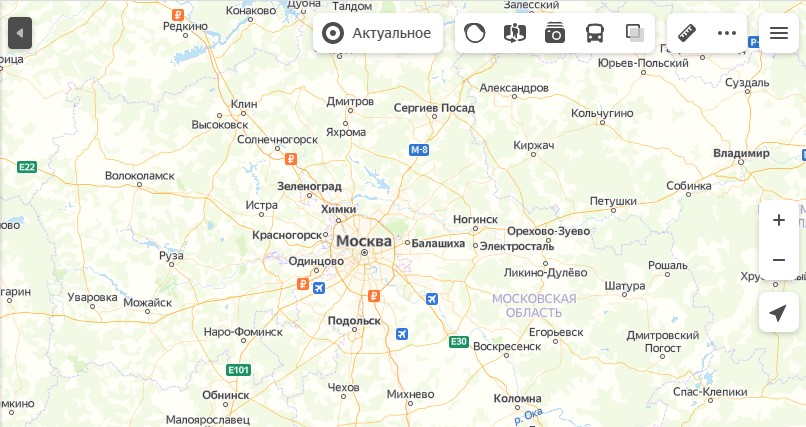tEvery month, more than 50 million users make over 210 million queries on Yandex.Maps, looking for companies directly by name, but more often than not searching for products and service by their deliverable, such as [good cafe near me], or [car repair garage near me].
This is a substantial number of users choosing to not use the traditional Yandex Search interface, and something that – if you rely on footfall and/or local customers – you need to optimize for.
The first step in being able to optimize your listings on Yandex.Maps is to first understand which variables correlate the strongest with the best performing listings, and with this understanding, take their benchmark and strategize how you can do that +1.
Yandex.Maps Correlating Ranking Factors
The four elements below have shown correlations with performance in Yandex.Maps over the years. These elements are:
- The proximity of the user performing the search to the business establishment
- The balance of reviews (number of positive reviews, freshness, frequency v negative reviews, business owner responses)
- Maps rating
- Brand signals (brand actually engages in marketing, has a presence generated through traditional marketing – this can be tied to citations, Zen channel)


User Proximity
Unless you’re a multi-chain establishment, this isn’t something you’re likely to be able to optimize for directly – however, you can still standout on the maps by optimizing for the other correlative factors.
Yandex.Maps can, does, and will often prioritize a location that is slightly further away from a user than others if it has really good reviews and interaction, a high maps rating, and a lot of positive brand signals.
This however can be a sticking point if user-signals suggest to Yandex average travelling distances for specific products and services, or if the distance is generally too great/beyond that of a reasonable travelling expectation.
Managing Reviews
Reviews are an important marketing and sales tool, regardless of their correlative impact on organic search performance.
They play an important role in the overall “journey” and can impact all phases of the what is referred to in sales as “the funnel”. Reviews can help with discovery (through impact on SEO) and then as a mechanism to build trust and legitimacy as a user moves closer to conversion.
They are also one of the best forms of user feedback if and when they are managed and analyzed properly. They can tell you:
- How and where an experience is at it’s strongest, and at it’s weakest
- The USPs and value attribution that your end-users apply to your company
- How you’re perceived in relation to competition, e.g. if your service is deemed as slow, does that mean a competitor is setting the benchmark and is faster?
- Potential product/service development areas
- How end-users are actually interacting with, and using your offering
- When, where, and how you can close any experience gaps
In these bullet points I talk a lot about experience, and experience gaps – but experiences aren’t linear and with a single product/service an end-user can have multiple experiences.
Brand Experience (BX)
This type of review often relates directly to the company directly, and are often detailed and focused on a specific branch/store.
These reviews can include all kinds of things, from their expectations of your product range to the temperature of a café or store. As well as helping to identify trends in what customers expect and appreciate, they can help you gather an overview of sentiment towards your brand and the kind of emotions your brand experiences elicit.
Customer Experience (CX)
It’s always good to remember that your customer’s experience is just as important as how great your product/service is.
No-one will rate your restaurant if your staff are rude and slam down silverware, despite the food being Michelin star.
CX reviews will likely touch on the timeliness and friendliness of staff in terms of both service and issue resolution, and how confident the customer has felt that their needs have been met. In some circumstances, it will not be possible to meet their needs or resolve their issue and by token they may leave a negative CX review.
Negative CX reviews are extremely useful feedback mechanisms and should be welcomed and responded to warmly, and if possible get even more information through a private channel no matter how hard or discouraging it may be to hear.
If processed correctly, this feedback data can help you identify potential issues within processes or put in place better internal functions to leave customers with these similar issues in common coming away from the interactions with higher levels of satisfaction, making them less likely to leave a negative CX review.
Product Experience (PX)
This, for me, is were a lot of businesses fall down. Reviews of the product/service are great, and PX reviews when displayed can help increase user trust and conversion rates.
They can also help identify marketing messaging issues and gaps between user expectation and product satisfaction fulfilment.
Reading the PX reviews of competitor products can also help you identify potential marketing messages, and even product developments, to help your product either better resonate with the target consumer base, or even develop end-user desired competitive advantages.
How Yandex Judges Review Quality
There are a number of services, that for a fee, who will publish positive reviews on your map listings, or negative ones on your competitors should you be so inclined – however, Yandex is aware of this and has measures in place to judge and add weighting to the overall quality of a review.
We’ve established two key correlating factors that may influence review quality scores, these being user geography and user account age/activity.
For physical stores and cafes, the user will leave a data trail to show where they go geographically (via their smartphone), so someone leaving reviews for a restaurant in Moscow who has no data trail indicating they’ve ever been to Moscow (or around the time of the review) will carry less gravitas than a genuine local.
Similarly, older accounts with more activity and reviews tend to be trusted more than newer accounts.
Other Map Factors
To further increase your chances of performing well within Yandex Maps (with your listings) you should:
- Upload as many relevant and useful photos as possible to improve user engagement metrics.
- Be thorough with information and where possible include things like prices and a list of products/services. Any text you provide is taken into account when the listing is scored and in a plain text retrieval system, the more information you provide can lead to increased matches from user search.
- Share news and updates via the posts feature to further improve engagement metrics and increase the text/semantic relevancy of the listing for user search.
- Utilize Yandex.Dialog and actively communicate with users.







